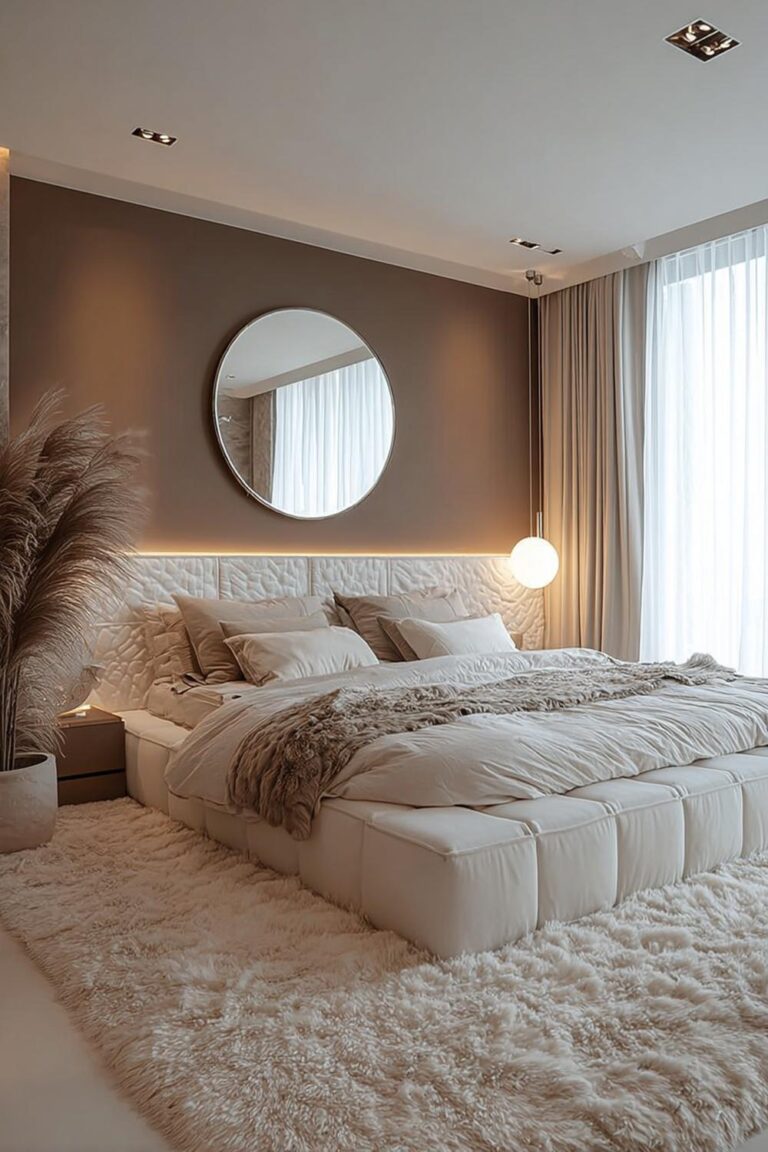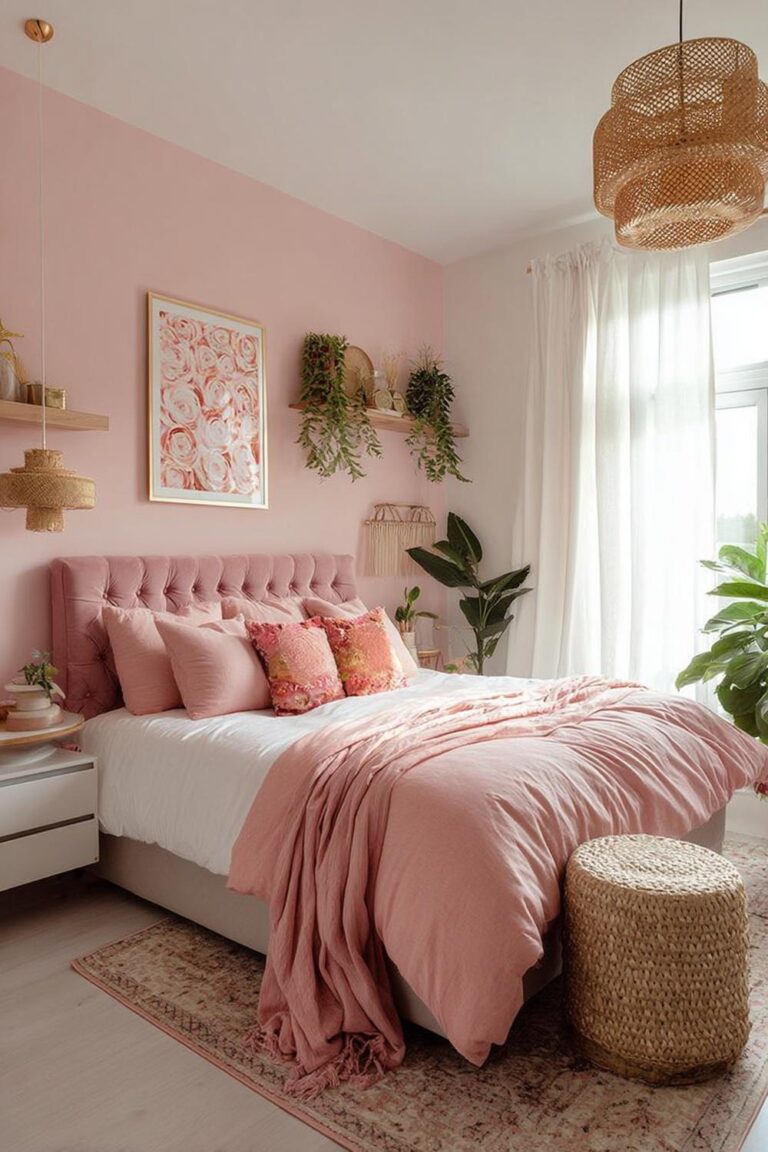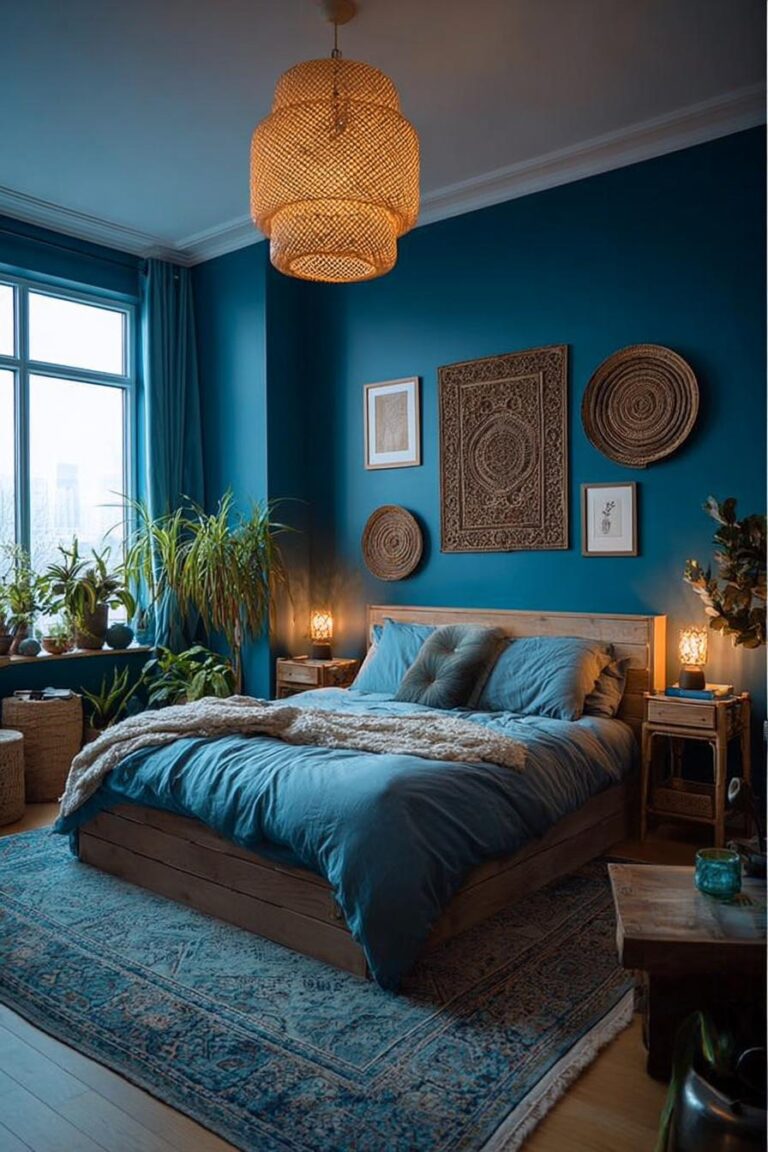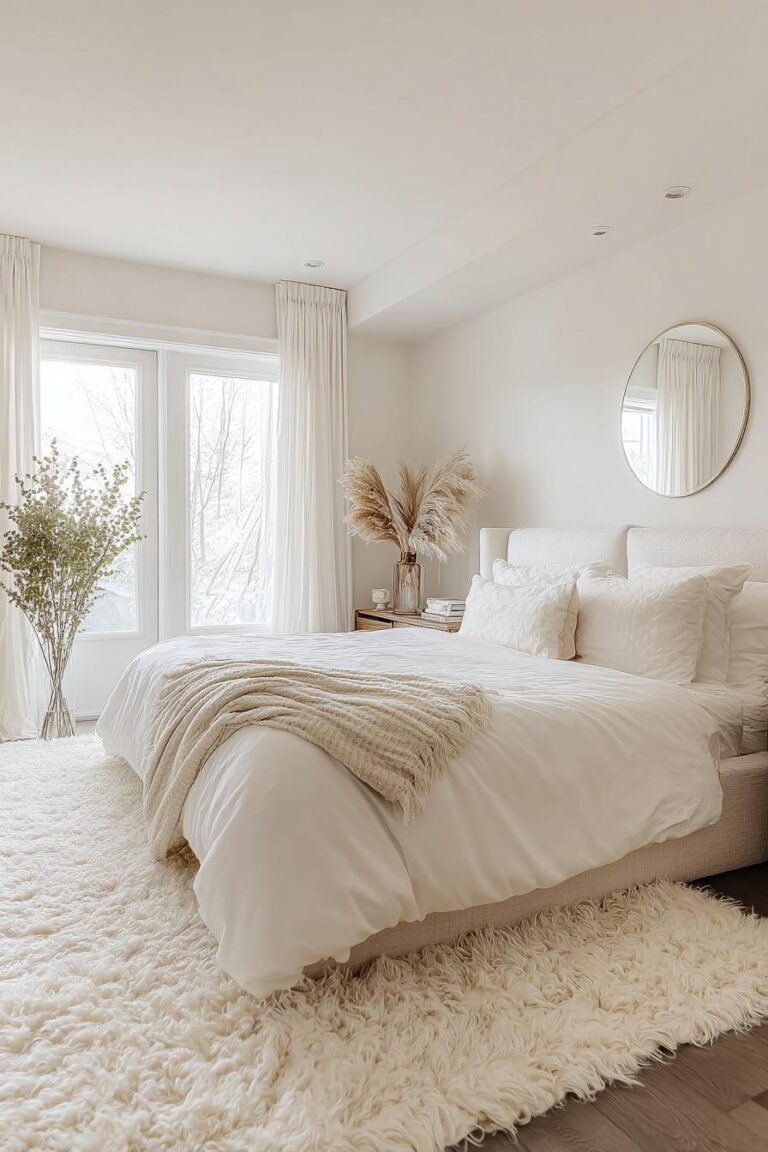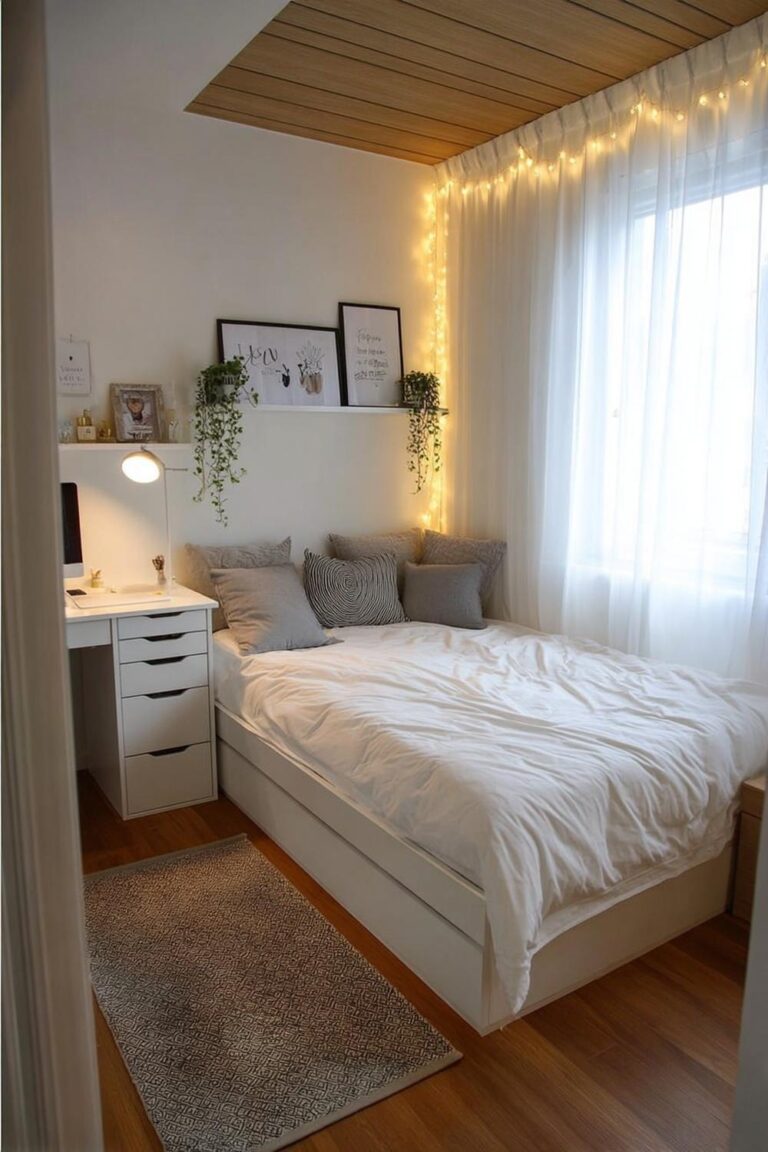Grey has quietly become the chameleon of bedroom design – it shifts from cool sophistication to warm sanctuary depending on how you style it. Whether you’re working with charcoal walls or dove-grey linens, this versatile shade creates a foundation that welcomes both bold statements and whispered accents.
1. Pair Sleek Black Nightstands with Soft Grey Wall Paneling
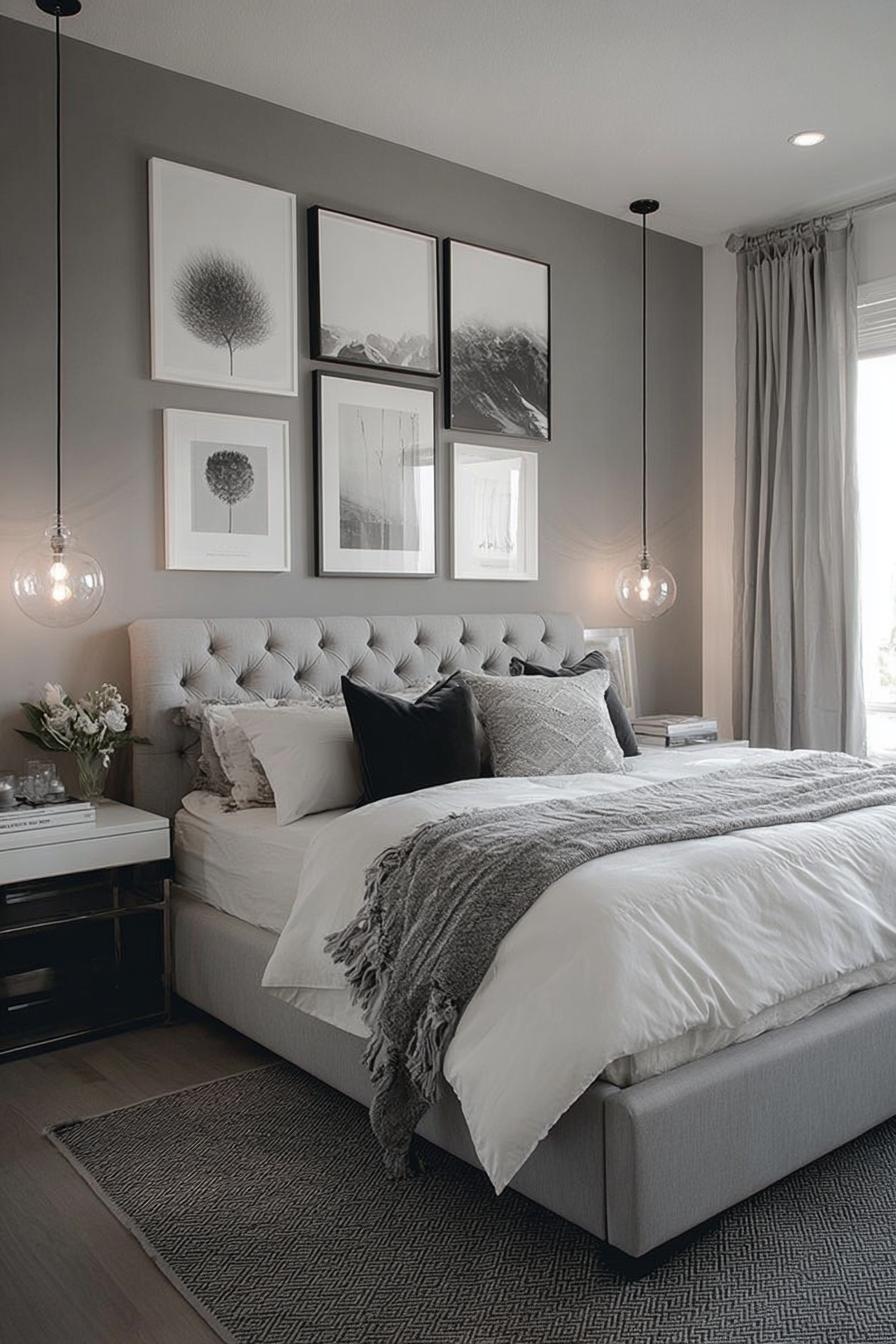
The stark contrast between midnight-black furniture and cushioned grey panels solves that age-old bedroom dilemma: how to create drama without sacrificing serenity. You know that feeling when a room looks flat? This combination eliminates it instantly.
Grey wall paneling – whether you choose horizontal shiplap or vertical beadboard – softens the bedroom’s architecture while black nightstands anchor the space with geometric precision. The interplay creates visual rhythm that draws your eye around the room rather than letting it settle in one spot.
2. Bring Warmth with a Chunky Beige Area Rug
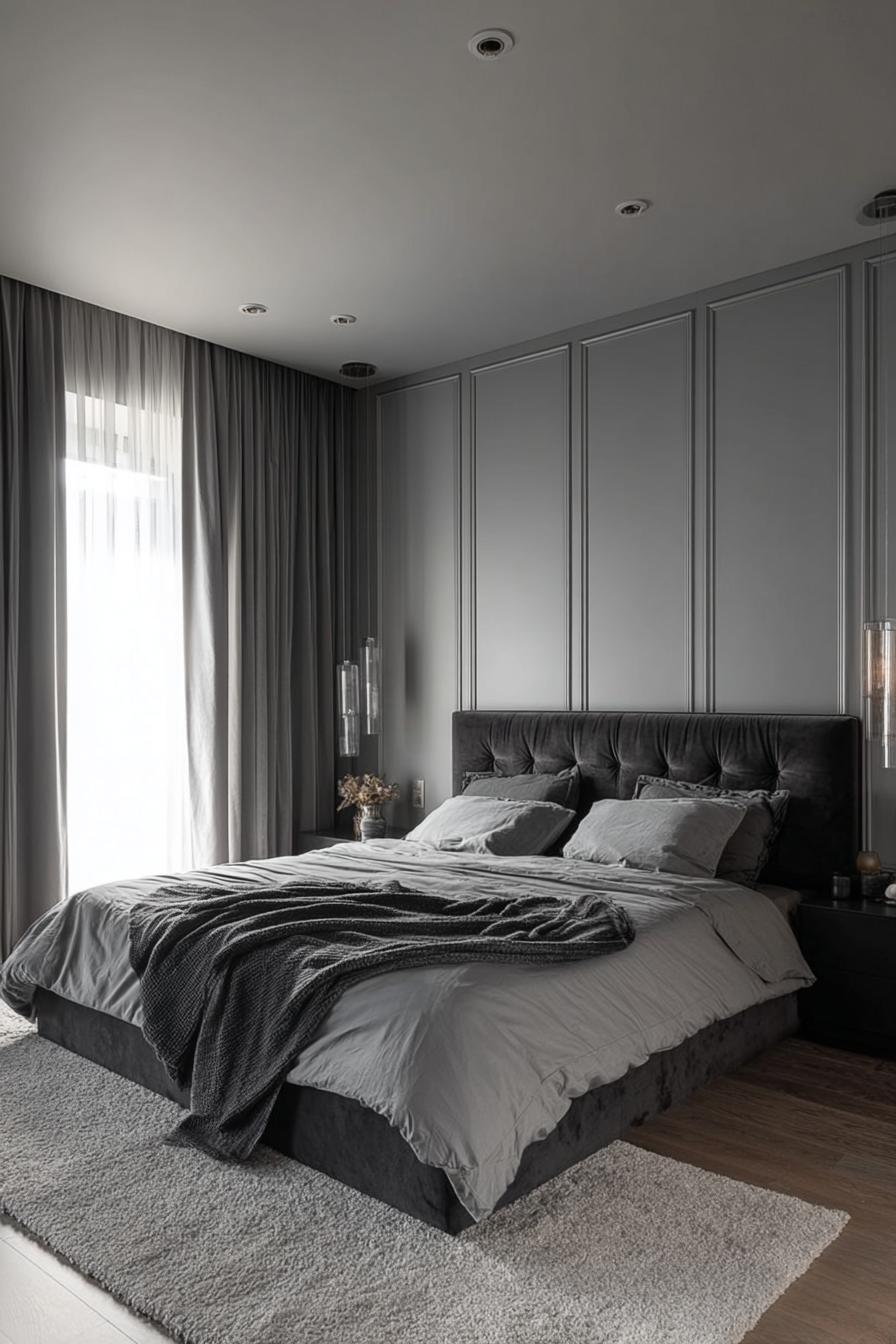
Most people overlook the floor when designing a grey bedroom, focusing instead on walls and bedding. Yet it’s the ground beneath your feet that sets the room’s temperature – emotionally speaking.
A thick, nubby beige rug beside your bed transforms cold morning wake-ups into something more bearable. Picture those loop-pile textures or chunky wool weaves that practically beg for bare feet. The beige tone bridges the gap between sterile grey and lived-in comfort, especially when you layer it over hardwood or laminate flooring.
Here’s the catch though: avoid rugs that are too small. A tiny rug floating beside your bed looks lost rather than intentional – go for at least 5×8 feet to create proper proportions.
3. Incorporate Black Pendant Lighting For Dramatic Visual Impact
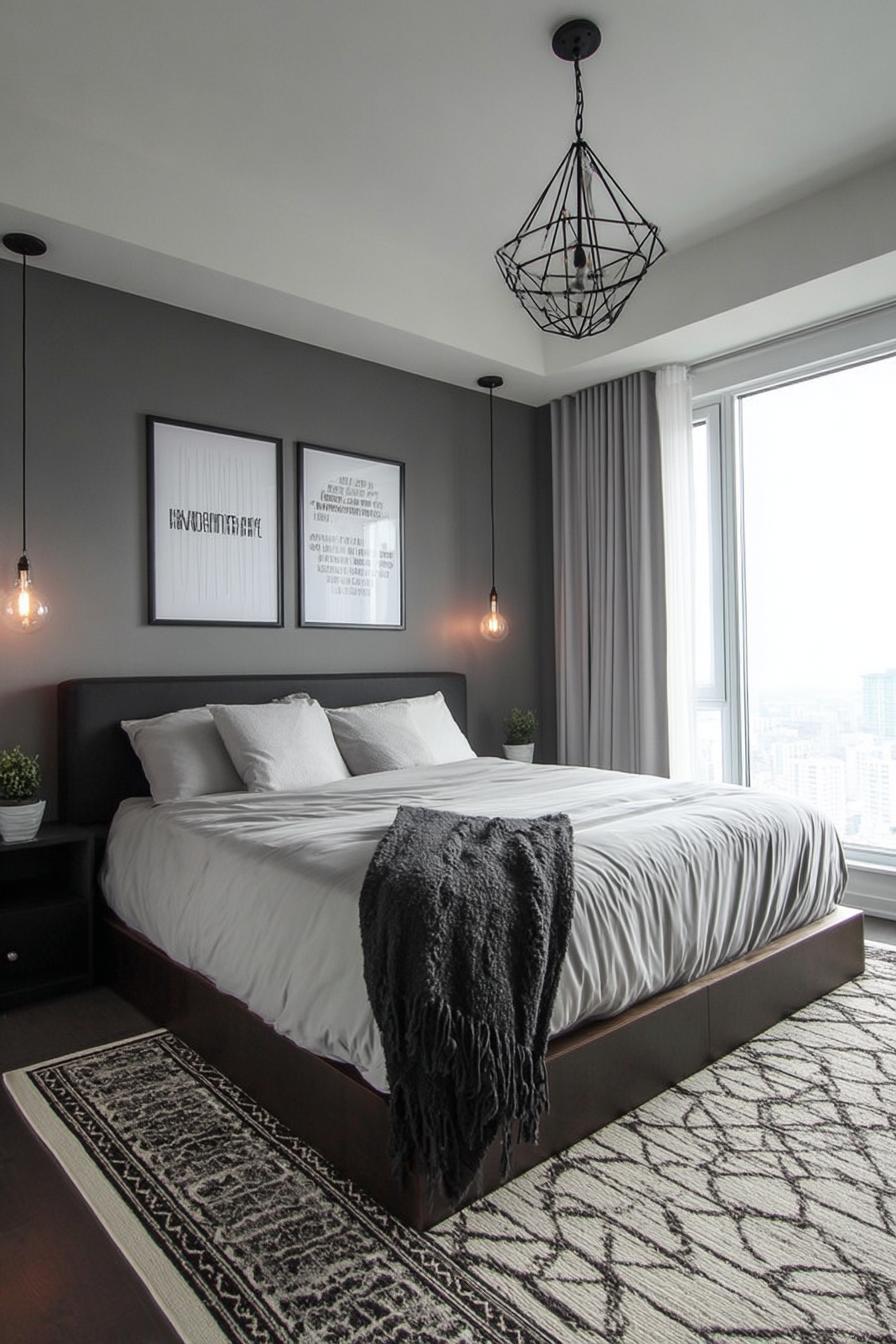
Building on those black nightstands from earlier, suspended pendant lights continue the dark accent theme but lift it skyward. The shadows they cast at night create an entirely different bedroom personality.
Think about boutique hotels you’ve admired – they often hang industrial-style pendants or sculptural globe lights instead of predictable table lamps. You could mount them on either side of the bed, dropping them low enough to free up nightstand space for books and water glasses.
The black fixtures against grey walls create negative space that feels intentional, almost gallery-like.
Quick tip: install dimmers. The difference between full brightness and a gentle glow transforms your bedroom from workspace to sleep sanctuary in seconds.
4. Arrange Contrasting Throw Pillows For Visual Interest on Grey Bed

Who says grey bedding needs to whisper? Sometimes it should shout – or at least speak up confidently through pattern and texture mixing.
The beauty of a grey foundation is its diplomatic nature with other colors. You can pile on mustard yellow cushions, deep teal bolsters, or crisp white euros without creating chaos. The grey grounds everything, letting accent pillows do the heavy lifting in terms of personality.
It seems like a small change, but suddenly your bed becomes the room’s focal point rather than blending into the walls.
Start with different sizes – 24-inch euros behind standard pillows, then layer in some lumbar shapes. Mix velvet with linen, cable knit with smooth cotton. The varied textures catch light differently throughout the day, creating subtle movement even when everything stays perfectly still.
5. Balance Natural Wood Furniture with a Grey Carpet
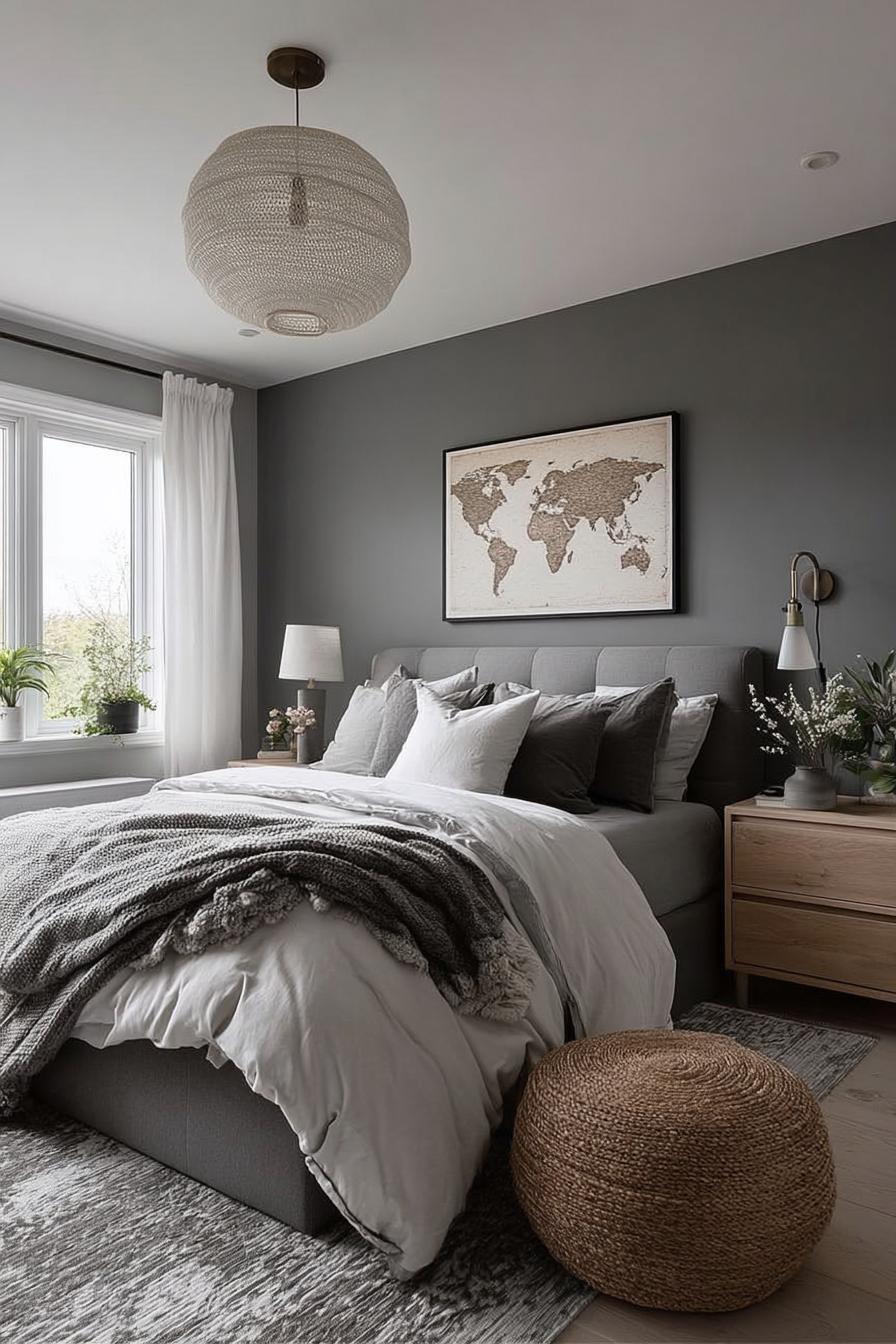
Strip away the polish and let raw oak or walnut furniture show its grain against plush grey carpeting. This combination feels both grounded and sophisticated – like a Scandinavian cabin met a city loft.
The carpet’s soft texture contrasts beautifully with wood’s hardness, while the grey tone prevents the natural elements from feeling too rustic. You end up with a bedroom that breathes easier, where the materials tell their own quiet story without competing for attention.
6. Curate a Cozy Reading Nook with Candlelight Beside the Bed

Forget overhead lighting entirely – sometimes the most sophisticated bedrooms rely on pools of candlelight to create atmosphere. It’s unexpected in our LED-obsessed world, yet undeniably romantic.
Position a small upholstered chair in your bedroom’s corner, then cluster pillar candles of varying heights on a nearby surface. The flickering light against grey walls creates moving shadows that no electric bulb can replicate.
Add a soft throw and suddenly you’ve carved out a retreat within a retreat – perfect for those nights when sleep feels distant.
7. Mix Raw Wood Elements with Grey and White Textiles
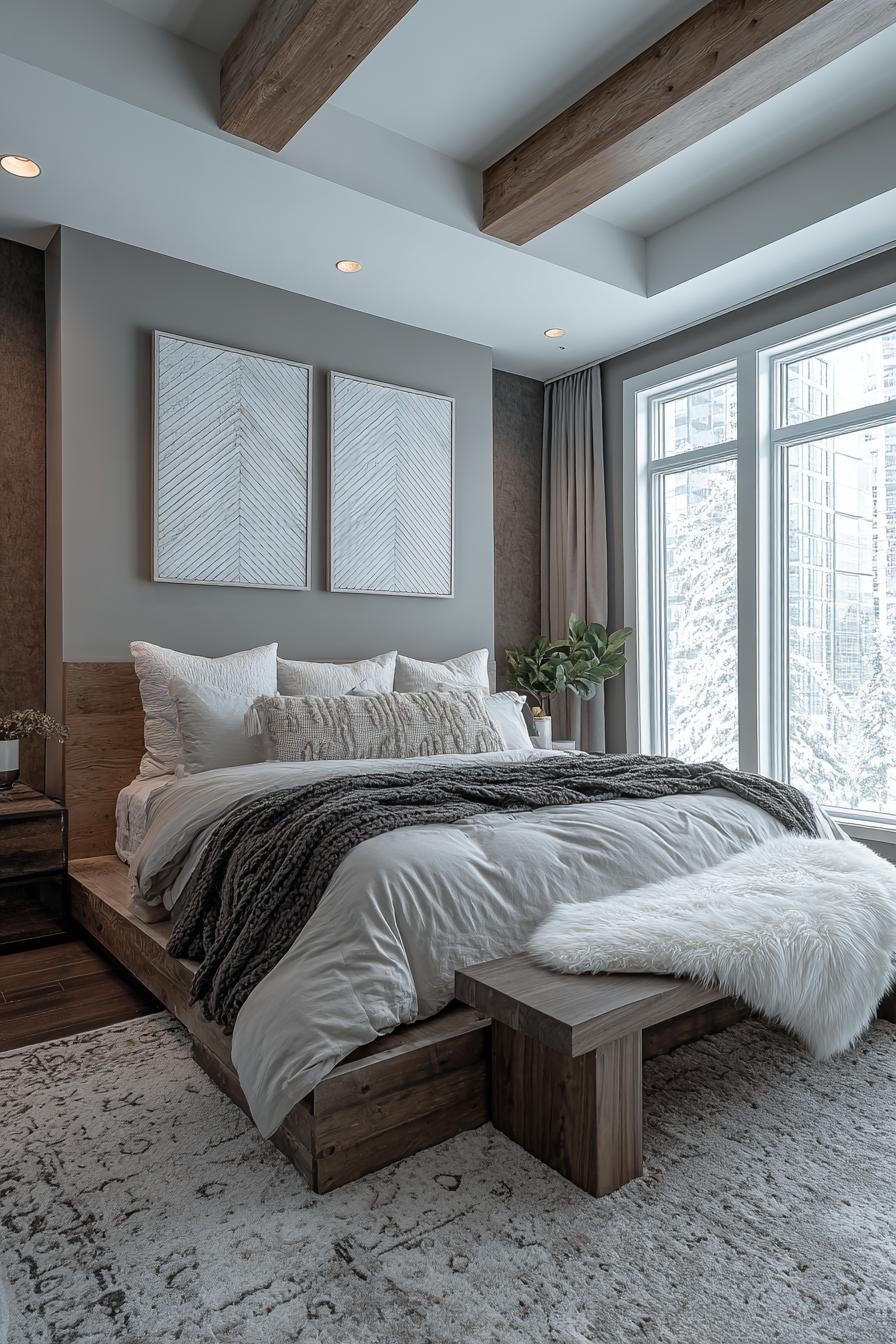
Think of your bedroom as a landscape where natural wood plays the role of earth while grey and white fabrics become clouds and sky. This metaphor guides your design choices toward harmony rather than random selection.
Weathered wood – maybe reclaimed barn boards as a headboard or live-edge floating shelves – brings organic lines into the geometric bedroom space. Layer in white sheets, grey duvets, and perhaps a cream cable-knit throw. The combination feels both refined and relaxed, striking that elusive balance between styled and livable.
The result? A bedroom that ages gracefully. While trendy colors might date themselves, this natural palette only improves as materials patina and textiles soften through use.
8. Spotlight a Fluffy Ceiling Lamp For Playful Contrast
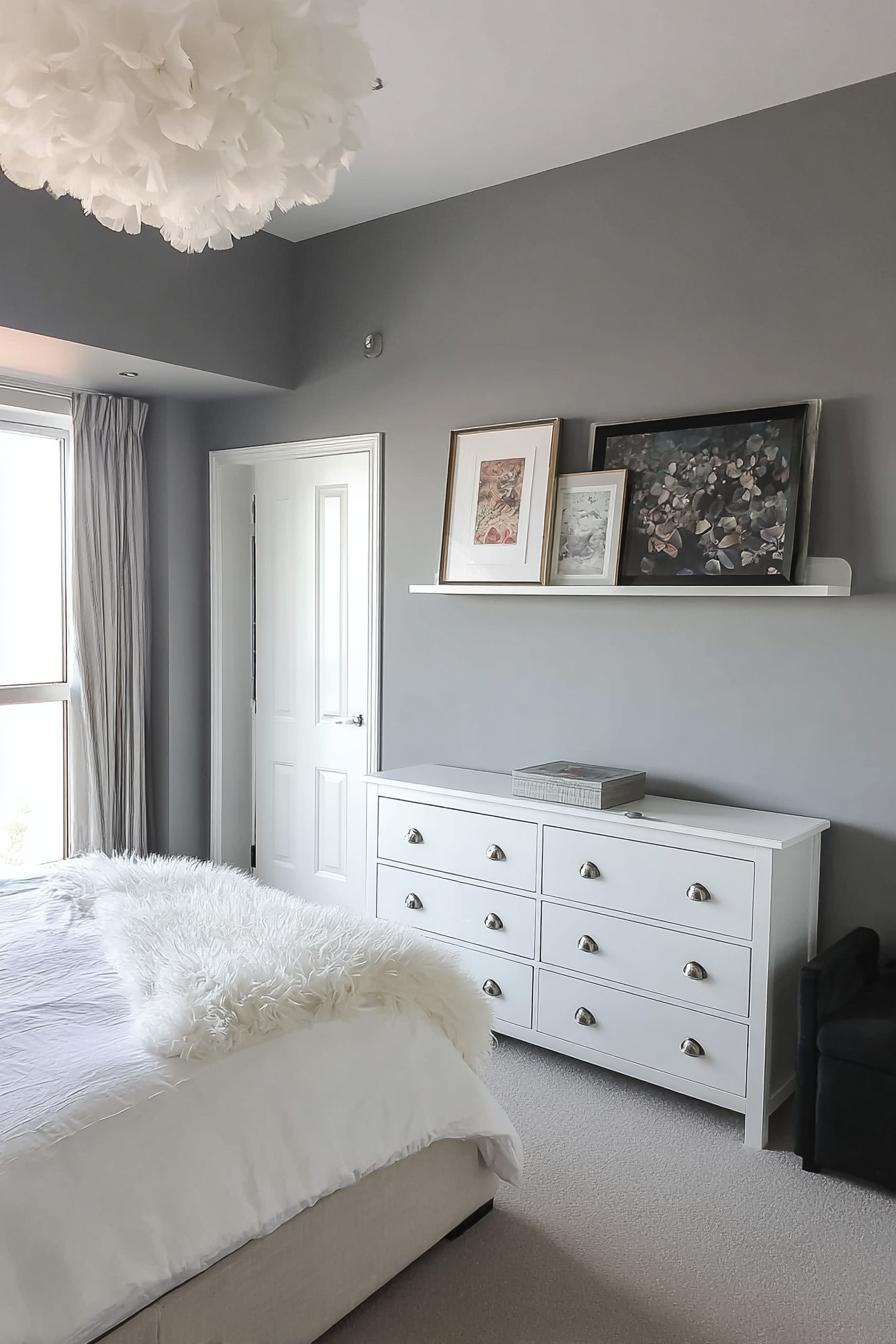
First, consider the unexpected: a cloud-like paper lantern or feathered pendant floating above your serious grey bedroom. Second, embrace the whimsy it brings.
These soft, organic shapes break up the straight lines that dominate most bedrooms – the bed frame, windows, doorways. A fluffy fixture draws eyes upward and adds movement even when perfectly still. Choose white or cream to maintain the neutral palette while introducing textural drama.
The shadows cast by layered paper or feathers create patterns on your grey walls that shift with air currents.
This playful element could become the next big thing in bedroom lighting – designers are moving away from harsh geometrics toward softer, more dreamlike forms that suit spaces meant for rest.
9. Contrast Crisp White Textiles Against a Soft Grey Bed
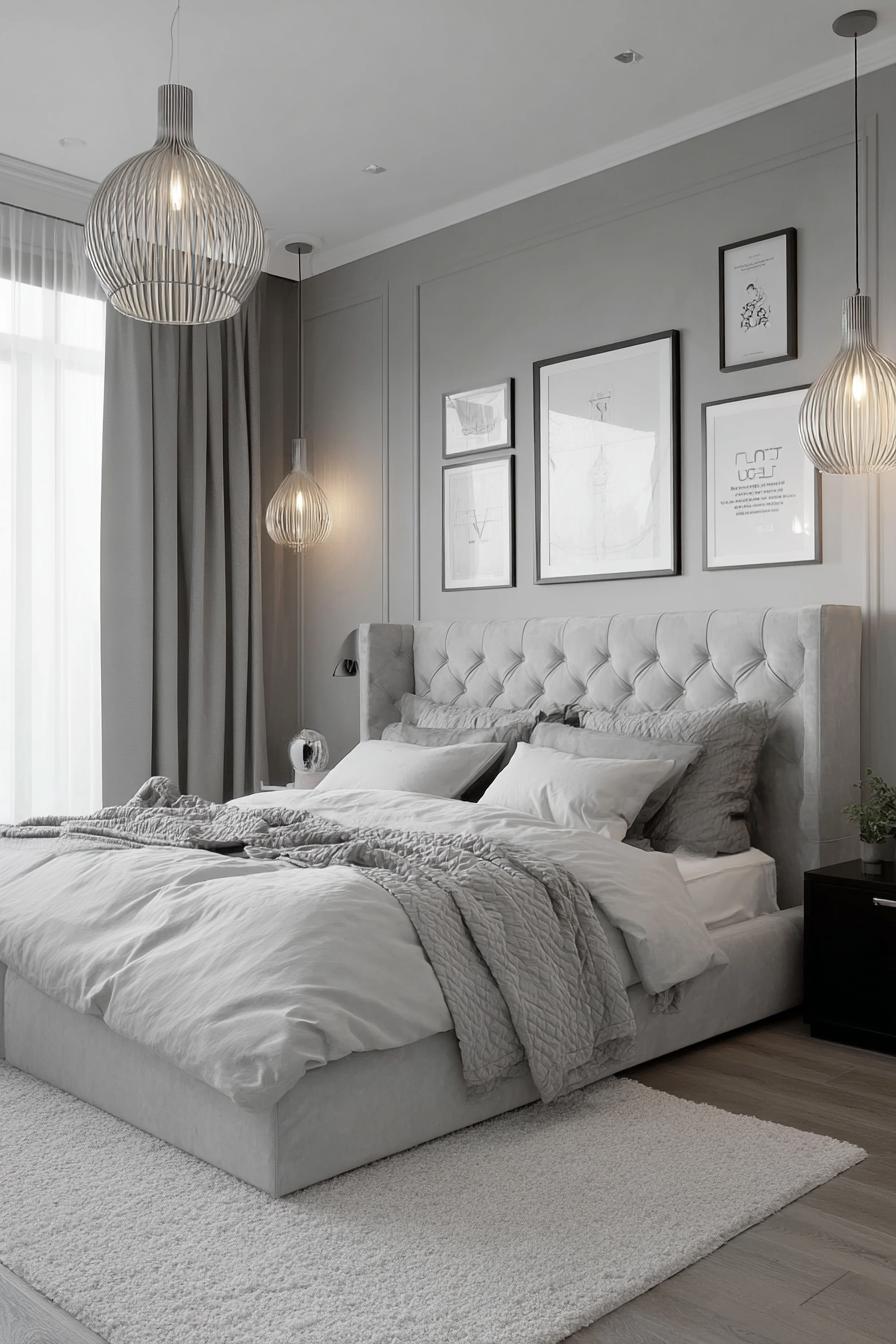
There’s something almost rebellious about pure white sheets on a grey bed – like wearing a tuxedo t-shirt, but make it sophisticated. The combination never fails to look fresh, even on day three of not making your bed (we’ve all been there).
White linens against grey upholstery or a grey duvet creates visual breathing room. Your eye bounces between the two tones, creating energy in what might otherwise feel static. The contrast sharpens both colors – the grey looks richer, the white appears crisper. It’s a designer trick that costs nothing extra but delivers hotel-worthy impact.
Go ahead – invest in those high thread-count white sheets you’ve been considering. Against grey, they’ll look even more luxurious than the price tag suggests.
10. Introduce Lush Green Plants to Energize a Grey and White Bedroom

You might think grey bedrooms lack life, but that’s exactly why they make perfect backdrops for verdant houseplants. The neutral canvas lets green foliage pop without competing colors getting in the way.
Snake plants beside the bed, pothos trailing from a high shelf, or a fiddle leaf fig in the corner – each adds oxygen and energy to what might otherwise feel too controlled. The organic shapes of leaves contrast beautifully with geometric furniture and straight lines.
Plus, certain plants like peace lilies and spider plants actually purify bedroom air while you sleep.
Indoor gardening continues to surge in popularity, and bedrooms have become the new frontier. Expect to see more sleeping spaces doubling as green sanctuaries in the coming years.
11. Lean Artwork Casually on Shelves Above a Grey Bed
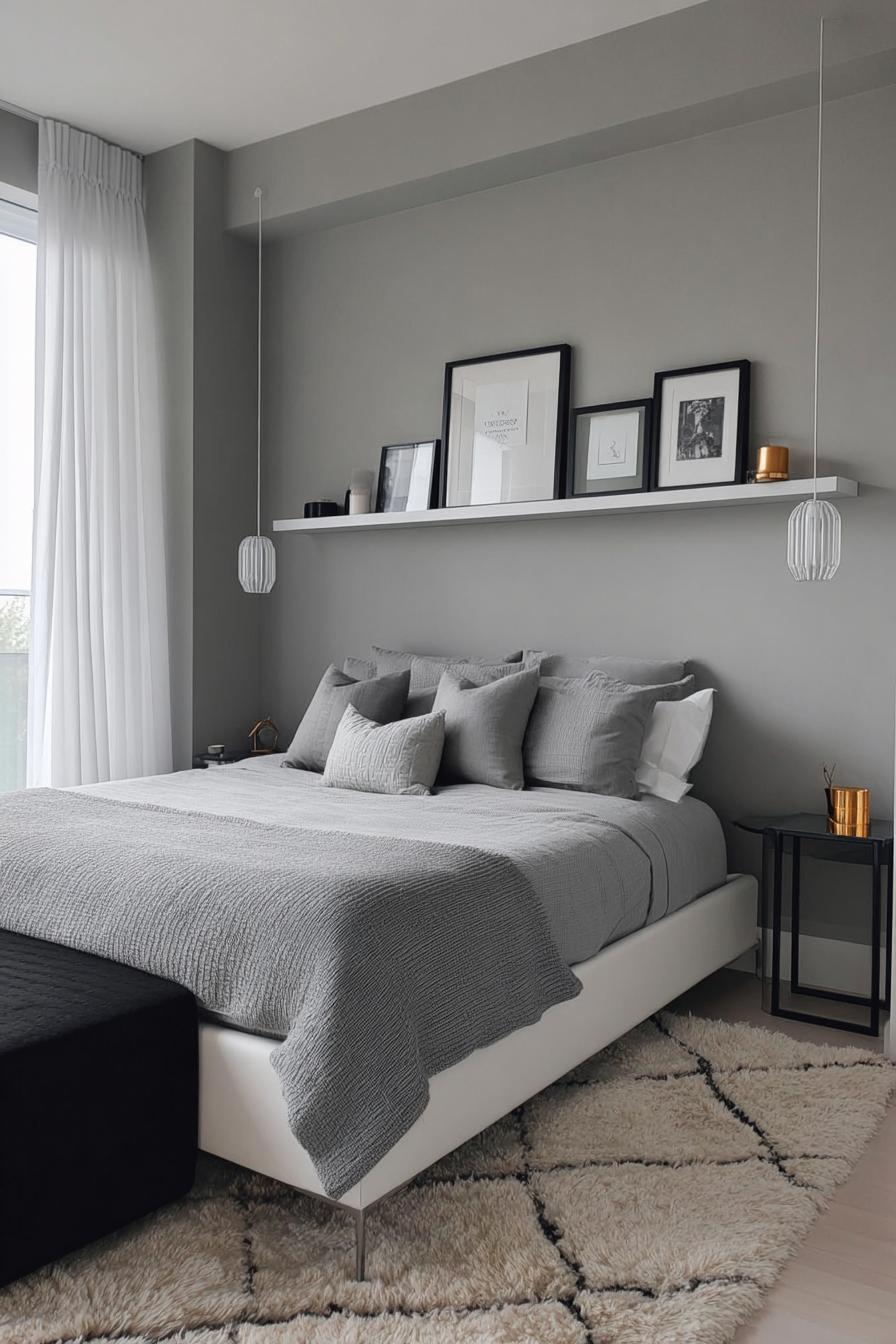
Gallery walls are exhausting to plan and execute. Leaning artwork creates the same visual interest with zero commitment and minimal nail holes.
Picture this: floating shelves in natural wood or matte black running above your headboard, with framed prints and canvases resting against the wall rather than hanging. You can shift pieces around when inspiration strikes, layer smaller works in front of larger ones, even mix in objects like ceramic vases or small sculptures.
The arrangement feels collected over time rather than purchased all at once – much more interesting than a perfectly aligned grid.
This approach works particularly well when you’re still figuring out your style, letting you experiment without permanence.
12. Showcase Minimalist Art Prints on Grey Walls For Subtle Texture
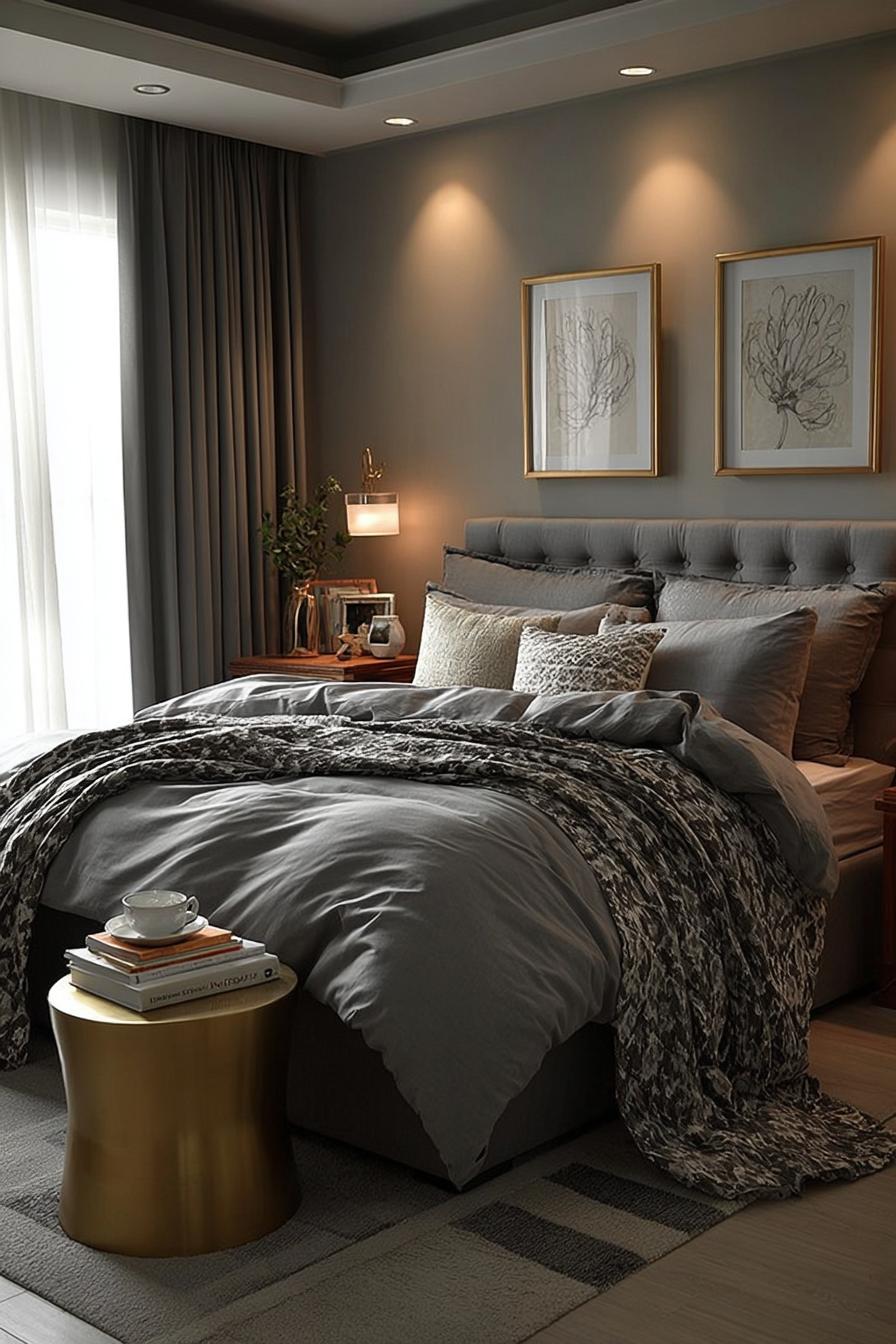
Did you know the human eye can distinguish around 500 shades of grey? Your bedroom walls provide the perfect testing ground for this bit of trivia, especially when you layer grey-toned artwork against grey paint.
Consider abstract line drawings in charcoal, architectural photography in black and white, or watercolor washes in various grey tones. A piece showing foggy mountains or rain-swept beaches echoes the wall color while adding depth through subject matter.
The monochromatic approach feels sophisticated rather than matchy-matchy – it seems like you’re creating a meditation on the color itself.
But here’s something to ponder: does matching grey to grey create harmony or does it risk monotony? The answer probably depends on your tolerance for subtlety.
13. Layer Tone on Tone Textiles For Depth on a Grey Floor

While everyone else reaches for contrasting colors, you could embrace grey’s full spectrum by layering different shades and textures underfoot. This approach requires confidence but delivers sophisticated results.
Start with your grey carpet or rug as the base, then add a lighter grey sheepskin beside the bed, perhaps a charcoal runner at the foot. Each piece should offer different texture – plush, flat-weave, shaggy – creating topography through touch rather than color. The effect feels rich and considered, like you’ve curated rather than decorated.
14. Highlight Natural Light Through Sheer Drapes in a Small Space
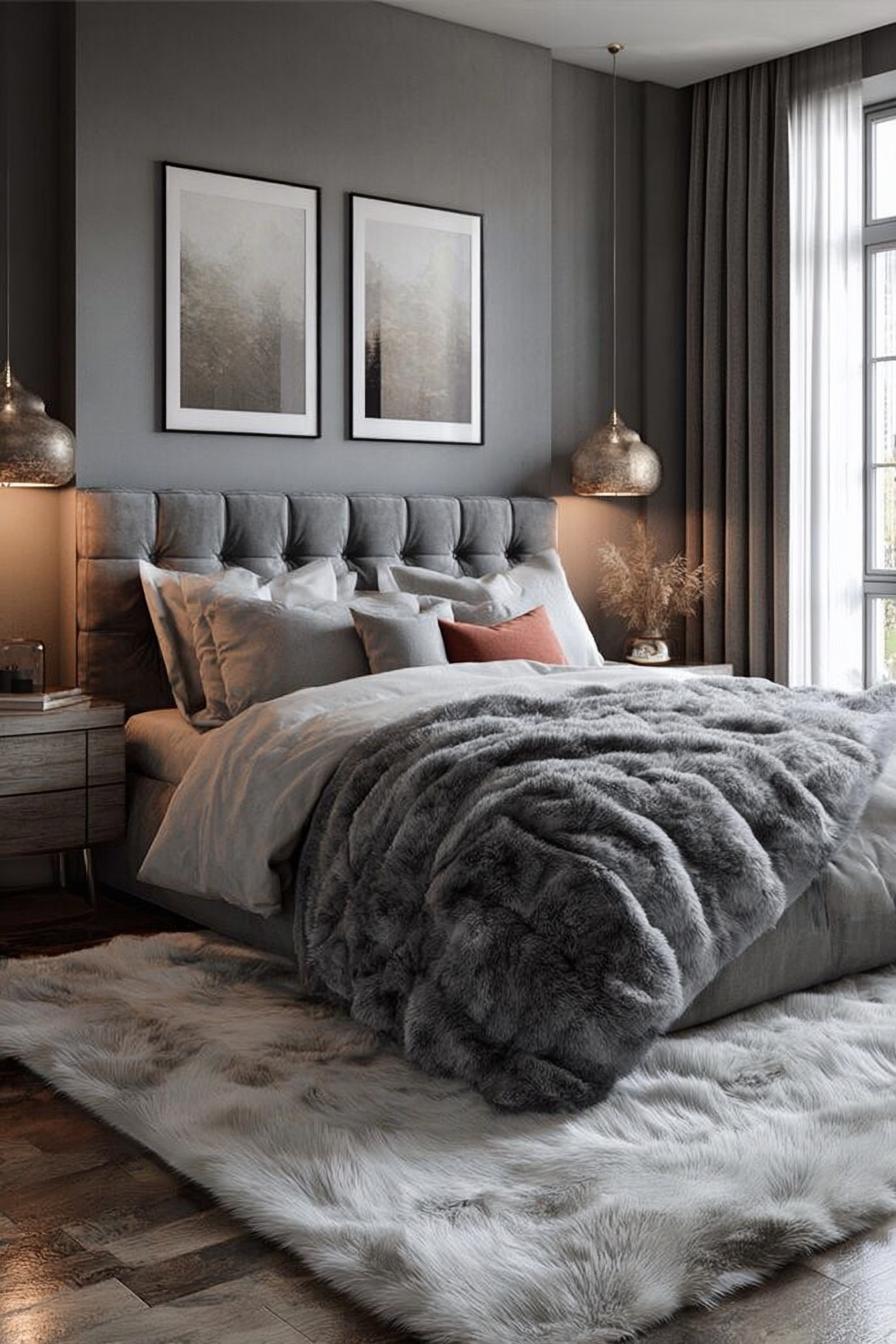
Sheer curtains work like Instagram filters for your bedroom – they soften harsh sunlight into something more flattering. Compared to heavy blackout curtains, sheers maintain privacy while maximizing every bit of natural light your small grey bedroom receives.
The filtered light plays differently on grey walls throughout the day, shifting from cool morning tones to warm afternoon glows. You preserve the view – even if it’s just neighboring rooftops – while creating a soft barrier between inside and out.
Small bedrooms especially benefit from this approach since heavy window treatments can make compact spaces feel even tighter.
Pro tip: hang sheers higher and wider than your actual window frame. This trick makes windows appear larger and floods more light into the room’s corners.
15. Opt For Mirrored Closets to Visually Double a Small Bedroom

The maximalist movement might be having its moment, but small bedrooms still benefit from strategic minimalism – especially when mirrors do the heavy lifting. Mirrored closet doors have shed their 1980s reputation and returned as space-expanding heroes.
Installing floor-to-ceiling mirrors on closet doors doesn’t just double your room’s visual square footage – it bounces light around grey walls that might otherwise absorb it. You create depth where none existed, and morning outfit checks become infinitely easier.
The reflection of your carefully styled grey bedding and coordinated pillows appears twice, amplifying your design efforts.
Modern options include antiqued glass for vintage appeal, bronze-tinted mirrors for warmth, or frameless designs that practically disappear. The mirrors themselves become design elements rather than purely functional additions.
16. Embrace Earthy Elements with Beige and Green Decor Accents
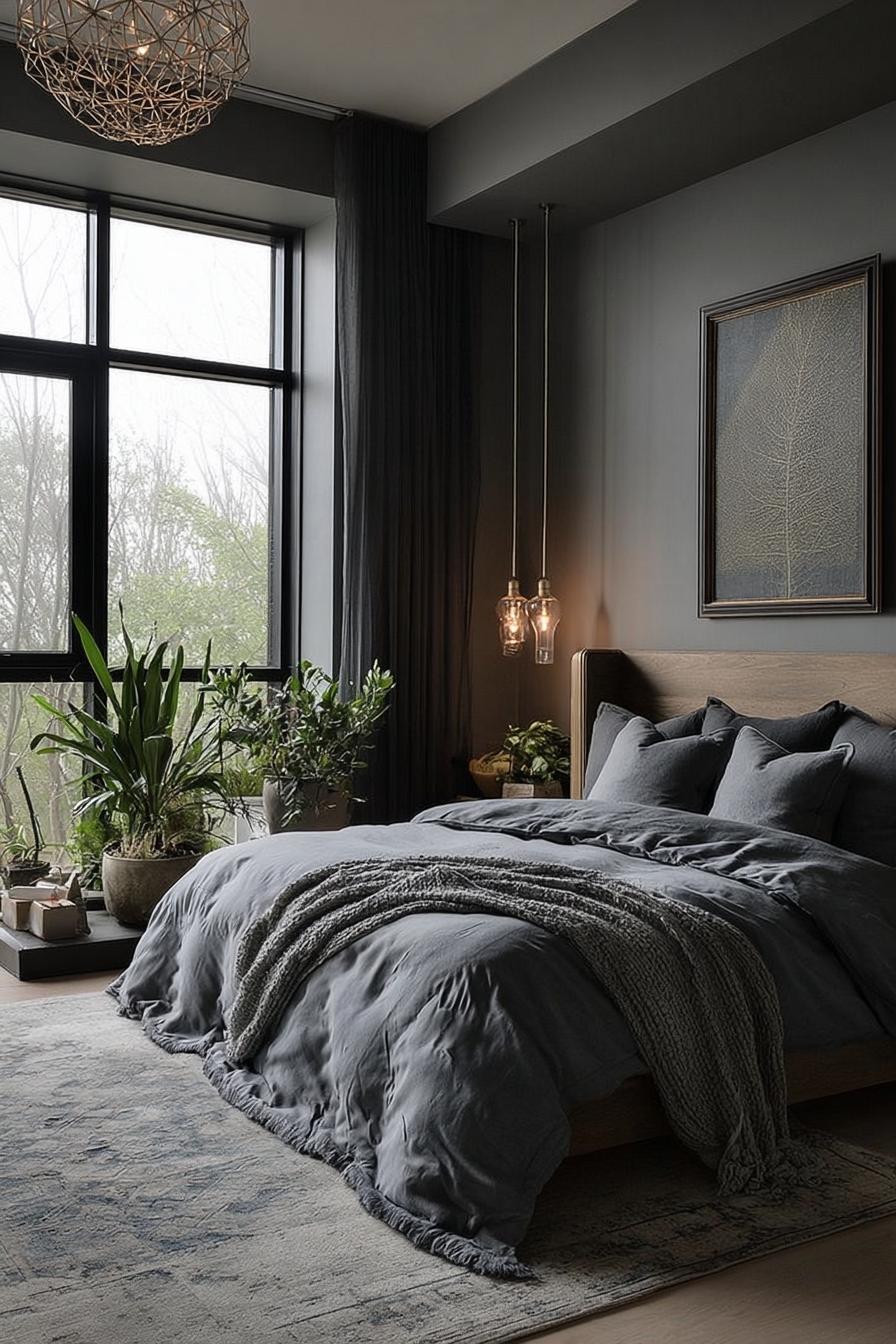
Why limit yourself to one neutral when you can orchestrate a whole symphony? Grey plays remarkably well with its warmer cousins – beige, taupe, and sage green.
These earth tones prevent grey from feeling too urban or cold. A beige jute rug, sage green throw pillows, or terracotta planters all inject organic warmth without disrupting the neutral palette. You’re essentially bringing the outside in, creating a bedroom that feels connected to nature despite its sophisticated grey foundation.
The combination suits those who find pure grey too stark but don’t want the commitment of bold color.
Careful though – too many different neutrals can muddy the waters. Stick to three or four tones maximum to maintain clarity and purpose in your design.
17. Select a Tufted Bench to Complement a Grey Bed
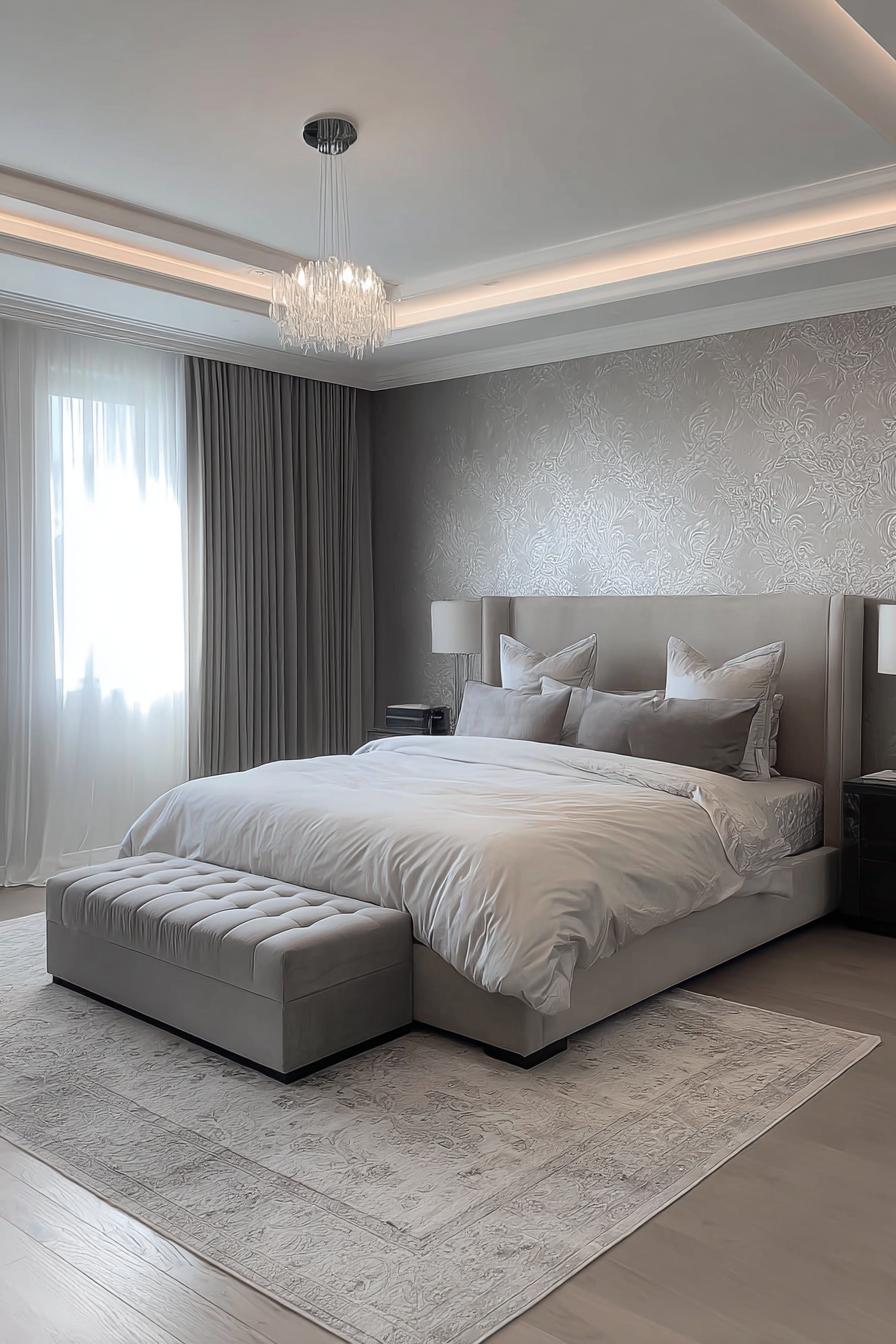
That space at the foot of your bed often goes unused – a missed opportunity for both function and style. A tufted bench changes everything about how your bedroom operates.
The deep button tufting adds textural interest that plain grey bedding might lack, while the bench itself provides a landing spot for tomorrow’s outfit or a perch for putting on shoes. Choose velvet in a slightly different grey shade, or branch out with blush pink or navy for subtle contrast.
The tufting creates shadows and highlights that shift as you move around the room, adding visual texture that flat surfaces can’t achieve.
Stop treating your bedroom’s foot as dead space – claim it with purposeful seating that earns its keep.
18. Arrange Geometric Wall Art For Modern Appeal on Grey Walls
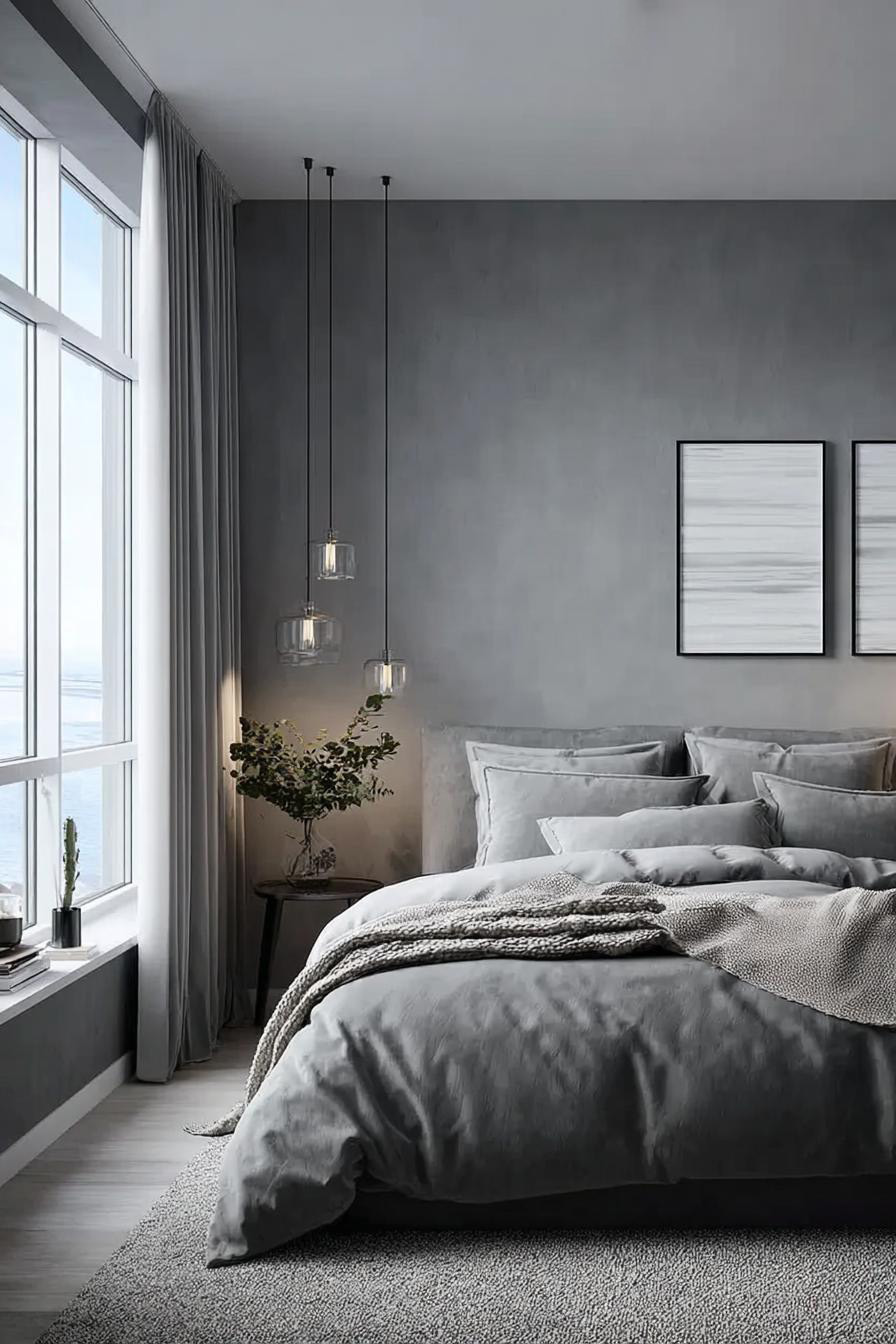
If your grey bedroom feels too soft or undefined, geometric art acts like architectural elements you can hang and rehang at will. Sharp angles and clean lines bring structure to an otherwise fluid space.
Think beyond basic triangles and circles – consider hexagonal mirrors arranged in honeycomb patterns, or metal wall sculptures that cast intricate shadows. These pieces work particularly well above a dresser or flanking the bed where they can create symmetry.
The key lies in choosing pieces where the geometry feels intentional rather than random, where each angle serves the overall composition.
The consequence of adding geometric elements? Your bedroom gains the kind of visual tension that keeps spaces interesting long after the initial decorating high wears off.
19. Frame Scenic Views with Oversized Windows on Grey Walls
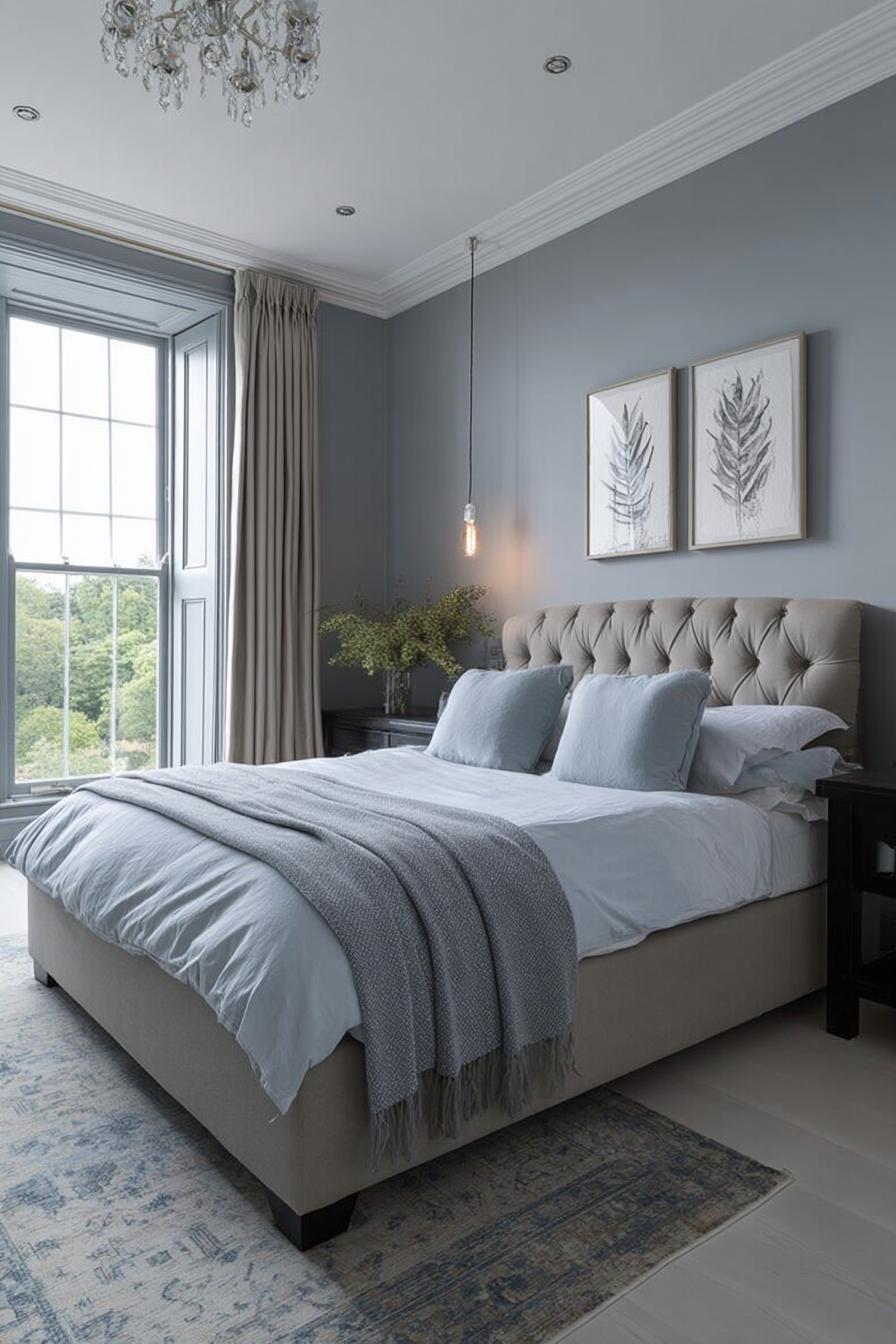
Let’s be honest – if you’re lucky enough to have oversized windows, you’d be foolish to cover them up completely. Grey walls become the perfect neutral frame for whatever view you’ve got, even if it’s just your neighbor’s surprisingly well-maintained garden.
Large windows transform throughout the day, acting as living artwork against your grey backdrop. Morning light creates one mood, afternoon another, and evening cityscapes or sunset colors provide the grand finale. The grey walls never compete with these changing scenes – instead, they recede politely, letting nature or cityscape take center stage.
Here’s a thought: consider painting the window trim the same grey as your walls. It makes the windows feel even larger and more integrated into the room’s design.
20. Draw Attention to Ornate Plaster Ceilings For Sophisticated Detail
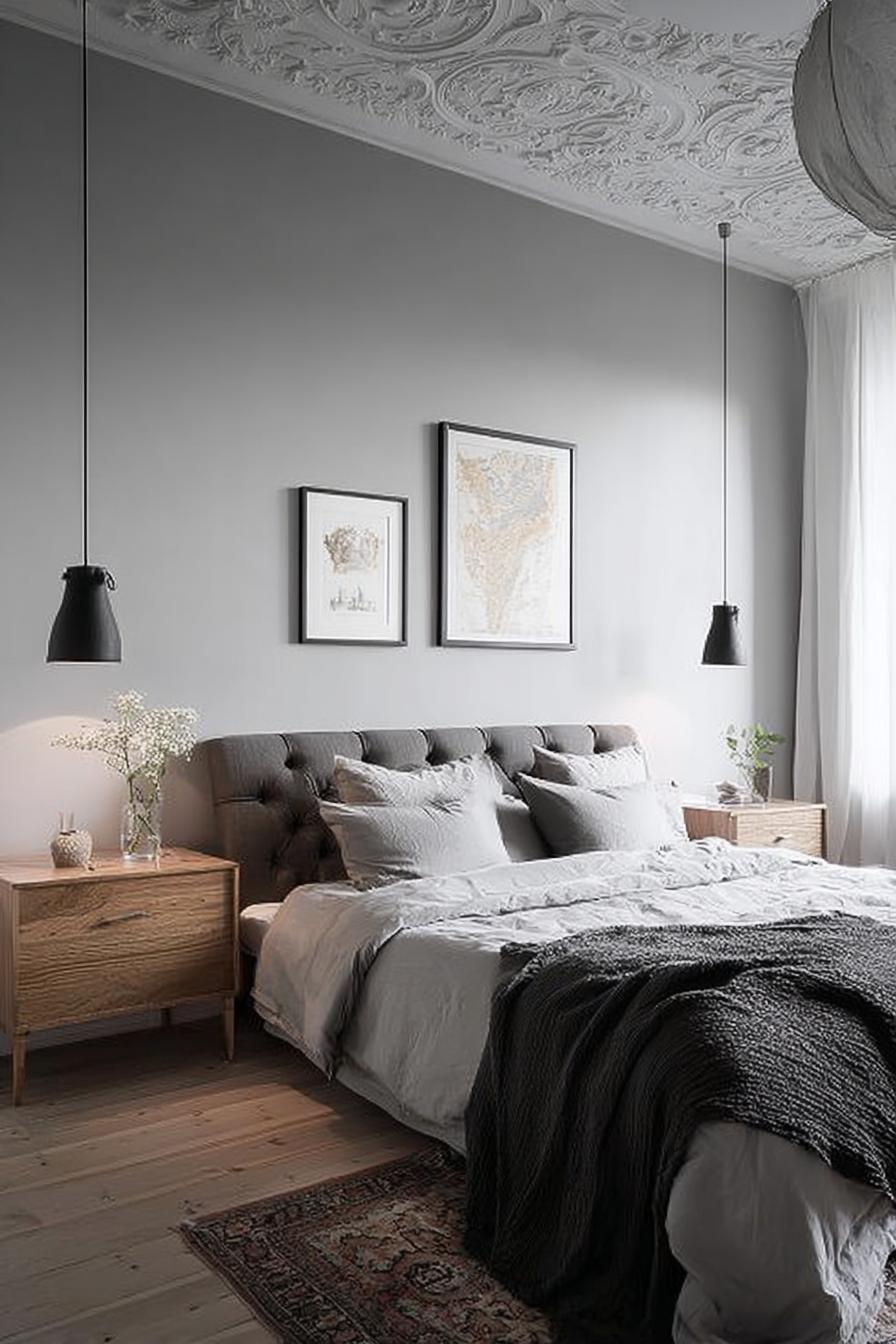
Your ceiling is like the fifth wall everyone forgets about – until you paint it grey and suddenly the ornate plaster medallion or crown molding becomes sculpture. This unexpected move transforms architectural details from background to foreground.
In older homes especially, these plaster details often get lost against white ceilings. A soft grey paint – maybe two shades lighter than your walls – creates just enough contrast to highlight the craftsmanship. The shadows within the plaster work become more pronounced, adding depth and history to your bedroom.
You’re essentially creating a three-dimensional artwork that happens to be permanently installed above your bed.
Grey ceilings make rooms feel cohesive and cocoon-like – the color wraps around you rather than stopping at wall height.
21. Use a Plush Grey Carpet to Soften Minimalist Bedroom Lines
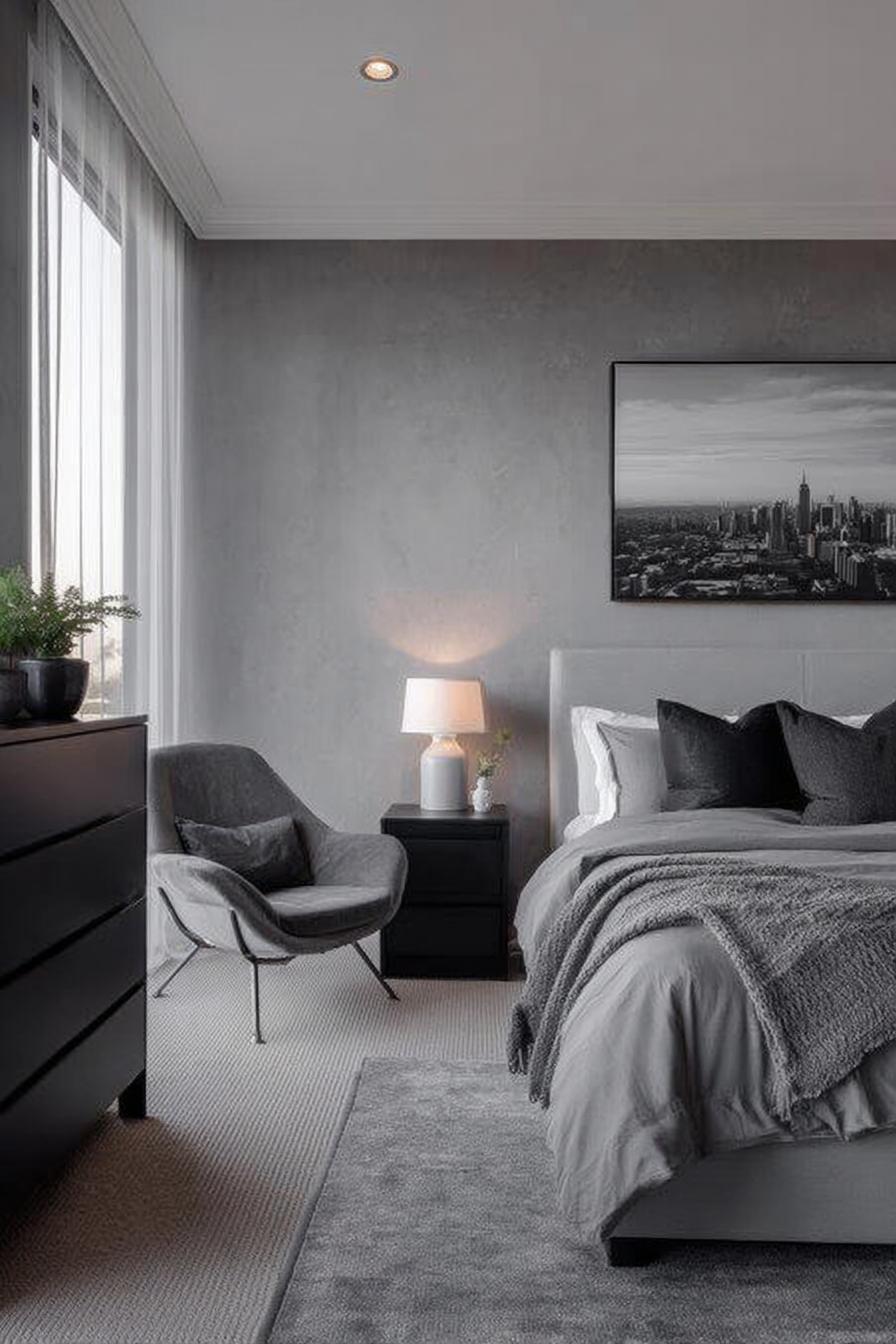
If you’ve committed to minimalist furniture with its clean lines and sparse decoration, plush grey carpeting provides the sensory relief your bedroom needs. Hard edges need soft landings, after all.
Minimalist bedrooms can sometimes feel austere – all those straight lines and empty surfaces might photograph beautifully but feel cold in real life. Wall-to-wall grey carpeting in a thick, luxurious pile adds warmth without adding visual clutter. Your feet sink in slightly with each step, providing tactile comfort that minimal design often lacks.
The carpet becomes a textural foundation that grounds floating furniture and prevents the room from feeling too precious or gallery-like – because you actually need to live here, not just look at it.
Conclusion
Grey bedrooms offer endless possibilities – you’ve seen how this adaptable shade partners with everything from crisp whites to warm woods, from geometric art to flowing plants. The key lies in choosing which direction speaks to you: will you lean into grey’s cool sophistication or warm it up with natural textures?
Start with one idea that resonates, then layer in others as your confidence grows. Your perfect grey sanctuary is waiting to be discovered.

